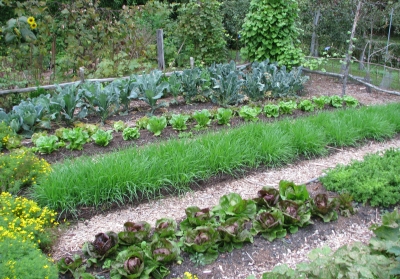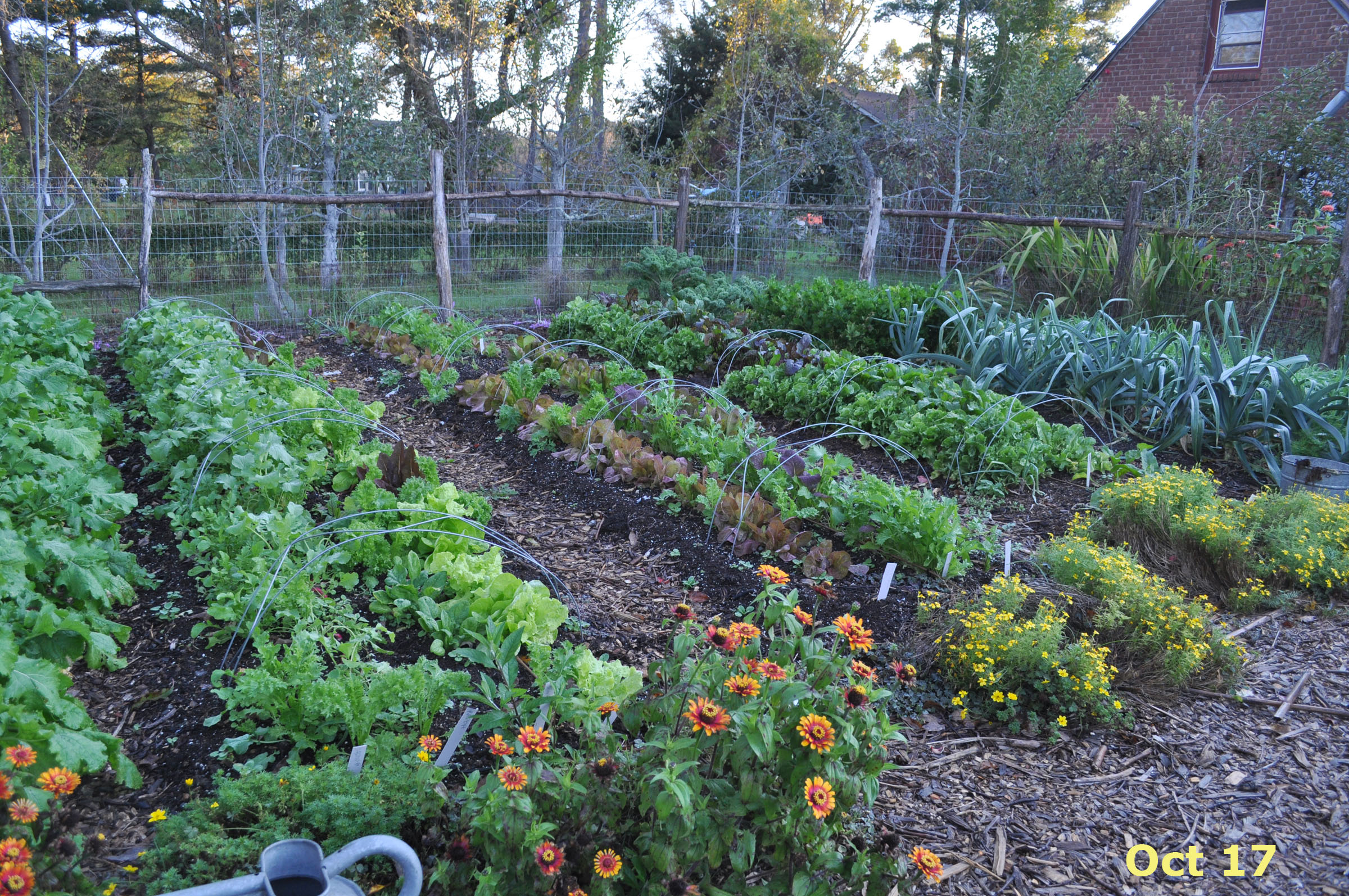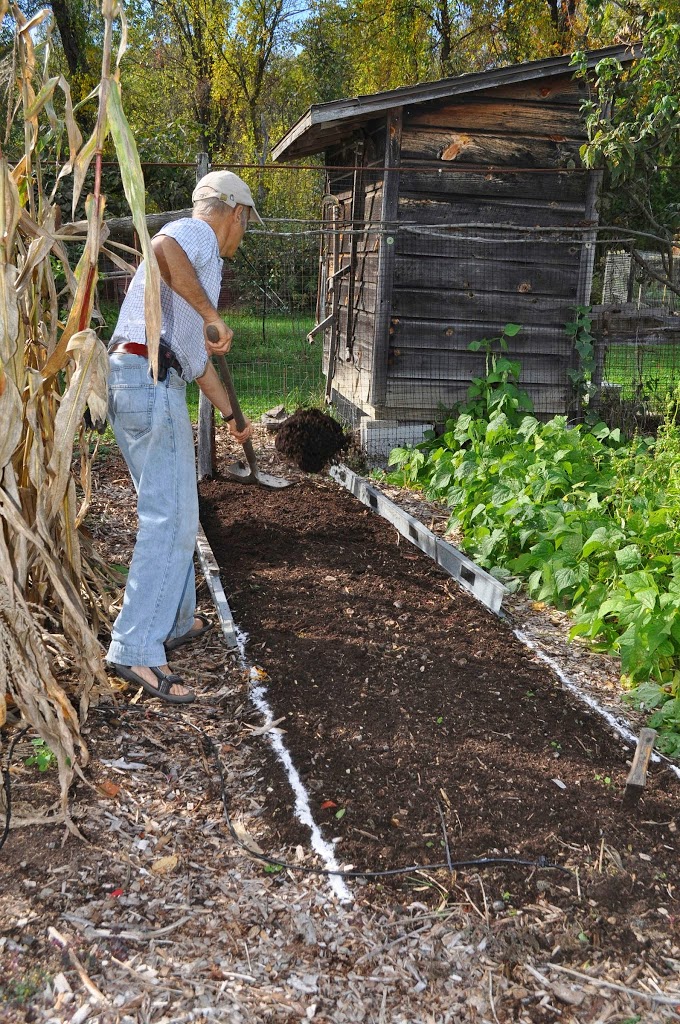COMPOST, FERTILITY, & SUSTAINABILITY
Compost and/or Living or Dead Organic Material = Sustainable Fertility
Maple leaves already dapple the ground in red and yellow (early this year), one morning showed off what was to come with frost on the windshield, and each day the sun each hangs lower in the sky, yet I’m getting ready for spring planting. Really! Yes, I’d rather do it now than in spring.
Beds of spent vegetables have been cleared. Okra plants, in this cool weather, just sat in place, hardly producing any new pods. So out went the plants. I severed the main roots with my hori-hori knife (www.oescoinc.com) and yanked out each stem. When corn is finished, it’s finished. Beds of early corn got replanted with endive, lettuce, and other late vegetables, but the latest beds of corn were harvested too late for replanting. Clearing away old vegetable plants not only clears the deck for next spring but also takes offsite some pests and diseases that might otherwise lurk around next year to do their evil work.
With spent vegetable plants cleared away — tomatoes and peppers are still yielding fruits, so they remain for now — I remove weeds. Ideally, all of them. Left in place, annual weeds spread seeds and roots of perennial weeds grab more tenaciously and deeper into the soil. A single pigweed plant, for instance, can drop 120,000 seeds, poised and ready to invade next year’s garden. That, and the 36,000 seeds on every plantain plant, the 39,000 seeds of each lamb’s-quarter plant, and the 8,000 seeds clustered in a crabgrass seedhead prompts me to pull these weeds now, before more seeds mature.
Of course, some weeds escape my notice, so the final step in preparation for spring is to suffocate these: I slather each planting bed with a one inch depth of mostly weed-free compost. A temporary 2X4 at each edge of the bed keeps the compost neatly in place until patted down firmly.
The compost does more than snuff out overlooked weeds. Its biotic life helps protect plants against pests and diseases. It helps soils hold water and air. And it feeds plants a smorgasbord of nutrients.
On a Garden, Farmden, or Small Farm, Fertility Simplified
Did I mention spreading fertilizer, “organic” or otherwise, in getting the soil ready for spring planting? No. A one-inch depth of compost supplies all the nutrients needed to grow vegetables, even in beds with closely spaced plants. Paraphrasing the Beatles lyrics, “All you need is . . .compost, da, da, da-da da.”
A garden is not Mother Nature left to her own devices; nonetheless, I try to emulate her as much as is practical. She does not spread fertilizer. Plants are naturally nourished as organic materials, such as leaves, stems, wood, roots, and dead animals, decompose to release whatever nutrients gave them life. I enjoy making compost and make enough to spread that required one-inch depth over all the beds.
Next best would be to spread some concentrated source of the most needed nutrients, that is, “fertilizer,” on the ground and supplement it with a mulch such as wood chips, straw, hay, or other organic material. Here, an organic fertilizer, such as soybean or alfalfa meal, has the advantage over a chemical fertilizer in that nutrients become available over a long time and are made so in response to temperature and moisture, in synch with plants’ needs.
Two advantages of maintaining fertility with compost rather than mulch plus fertilizer are that seeds are more easily planted directly in the compost and compost, if made from a variety of feedstuffs, provides a wider spectrum of nutrient for the plants.
Cover Crops, Used Correctly, for Even Large Farms
A wheat farmer in Montana is not going to be spreading an inch of compost on his 1,000 acres, or even soybean meal and a mulch of straw. Agriculture is a balancing act, again, not Mother Nature but not disrespecting her either. In the case of a wheat farmer, or any large scale farm, cover crops are a practical route to healthy soil.
Cover crops are plants grown specifically to maintain or improve a soil. Cover crops may occupy the ground for part or for the whole season. As they grow, their roots push through the soil to break it up and, upon their death, leave channels for air and water. Roots exude natural compounds that stimulate a a wide population of beneficial microbes and release nutrients from the soil’s rocky matrix. Leguminous cover crops garner nitrogen from the air into a form that plants can gobble up. And once dead, deliberately or with age, cover crops can maintain or increase all important soil organic matter.
The devil is in the details. Killed too young, while still lush and green, a cover crop adds nothing in the way of soil organic matter (but does protect the soil surface from erosion). Tilling a cover crop into the soil, a common practice, might burn up more organic matter, by giving the ground a big burst of oxygen, than is added by the cover crop, whether the cover crop is young or old. And then there is the choice of cover crop itself for regional adaptability, for shading out weeds, or for beefing up a poor soil.
How about this? Set aside a separate area for cover cropping each year. Or set aside a separate area for cover cropping, but mow the plants one or more times through the growing season to provide mulch or feedstuff for compost. With enough land and suitable mix of cover crops, including legumes for nitrogen.
—————————————-
“Sustainability” is a buzzword these days. Nourishing the ground with nothing more than annual sprinklings of chemical fertilizer not sustainable in terms of long-term soil health and because synthetic fertilizers require fossil fuels in their making. At he other end of the scale, primitive slash and burn agriculture, where land is cleared and burned, crops planted for a few years, then the site abandoned for a new site, is sustainable. But you need enough land to be able to leave time for the soil to naturally regenerate before another slashing and burning. In our “advanced” culture, recycling organic materials back to the land is also sustainable. It’s just a matter of getting the materials back into the soil, as compost or more directly, but not to a landfill or an ethanol (gasahol) factory.







Lee,
Just want to point out a broken link. The link behind the text “www.oescoinc.com” is http://www.oesco.com (Oklahoma Electrical Supply Company) and, of course, should be http://www.oescoinc.com (Orchard Equipment & Supply Company) instead.
Tom
Thanks. I just corrected it.
Lee,
We have herds of deer go through our growing area regularly. Drought has brought them ever more hungry which is why we planted our heirloom tomatoes in a protected spot. It is the only spot where we can protect them. I know the reason behind rotating crops, but is there any way tomatoes can be planted in the same spot next year?
You can plant them in the same spot every year; they’ll just be more likely to get pests. Pests could be mitigated to some degree if the site is sunny with good air circulation, if you do a thorough cleanup of everything after harvest, if the soil is healthy,, etc.
Lee, I am confused about the use of compost and mulch in my flower beds. I have applied compost as I plant new beds or rejuvenate old beds. I then use mulch on top. But how do I apply compost to existing beds? Do I pull off the mulch, apply compost and then re-mulch?
It depends on what mulch you use and how deeply you spread it. If it’s a high carbon mulch, such as wood chips or sawdust, and you spread it deep, covering it with compost would put it right in the root zone. There, microorganisms breaking down the high carbon mulch would need nitrogen, which, because they are better at taking it than plants, would leave plants starved for nitrogen — temporarily. If the mulch has been on the ground long enough to break down, or if it’s not very high in carbon, or if the layer is relatively thin, spreading compost on top shouldn’t be a problem.
Most flowers are not heavy feeders so I reserve my compost for my vegetables, which are heavy feeders, and mulch flower beds with leaves, wood chips, pine needles, etc.
Lee,
As I pulled out old bean & squash plants this fall, I sowed oat seeds, for the first time, as a cover crop in several areas of my raised vegetable beds. The most mature oats are now 8″ tall; the others abt. 4″. What’s the best way to handle these greens, as I think about planting next spring? I am in S.W. MA, zone 5.
Oats are an ideal cover crop for no-till. They’ll grow through the cool weather and die by February. In late winter or early spring, you can just pull or roll the dead tops off the beds and you’re ready to plant. Leave the dead roots in the ground, as is. For more on cover crops, etc., see my book WEEDLESS GARDENING.
Lee I so admire your meticulous garden beds! I typically clean up all my vegetable beds in Fall and throw on a layer of (or rather lather them – love that) compost even if it is not quite ready. It should break down enough to be ready by Spring do you think? I also mulch my veggies (and any cleaned up beds) with the lawn clippings. It seems to add to the soil but maybe I am just adding weeds? What do you think?
It all sounds good. Obviously, the true test is whether your plants look healthy and grow well.
Having just completed Weedless Gardening, I’m excited to integrate some of your techniques to repair my Weedful Garden. I’ve got some completed compost in my bins, but not nearly enough to cover the beds in my 50′ x 25′ vegetable garden, so I collected about 25 bags of leaves from my neighborhood. My plan is to lay down corrugated cardboard (putting my Amazon prime membership to good recycling use), shred the leaves using my riding mower, then spread them in a 1-inch layer in the beds to become compost. But I had a few quick questions.
1) Do you recommend that I do that this fall, or in the early spring? My main concern is that it can get windy at times throughout the winter, and I would hate for the shredded leaves to blow away.
2) When you talk about building new beds where there was previously grass/weeds, you say to fertilize with soybean meal before laying the cardboard. Should I do that even if I’m building on bare soil that most recently had vegetables and weeds growing on it?
3) Where in the Hudson Valley is a good source for soybean meal?
4) When it comes time to transplant tomato and other seedlings in May, will 1 inch of compost really be enough to hold the 6-inch plant steady without having to puncture the cardboard? It seems like they would just fall over.
I would use newspaper rather than cardboard. You want something to shade the ground and then decompose in not too long a time. Soybean meal is probably unnecessary if the ground is reasonably fertile. Fall or spring is good for starting a weedless garden. I get soybean meal from Agway. Make a hole in the cardboard — hopefully, you used newspaper instead — if necessary.
Great read. I have a Facebook page named 7 Heavenly Hens GARDEN where we chronicle raising chickens, honey bees, growing fruits and vegetables and growing kitchen herbs. This past year we grew in garden beds that surround our eco-lawn, Fleur de Lawn, and also tried straw bale gardening. This coming year we will experiment with square foot gardening in raised beds (2 of them at 4’x4′) and also a weedless garden area (3′ x 10′) which resembles a Back to eden method (covering with copost). Our covering is wood chips from a tree service company local to us. The key, as you say in your book and here on your site is the compost. We are making our own compost on site and also buy some from a local company. I took a class through our County extension office to become a certified Master Composter (classes are compleated and passed the test just need 10 hrs. of volunteer service for extension office for compost program). Thanks for all you’re sharing – wish i had learned about you sooner !